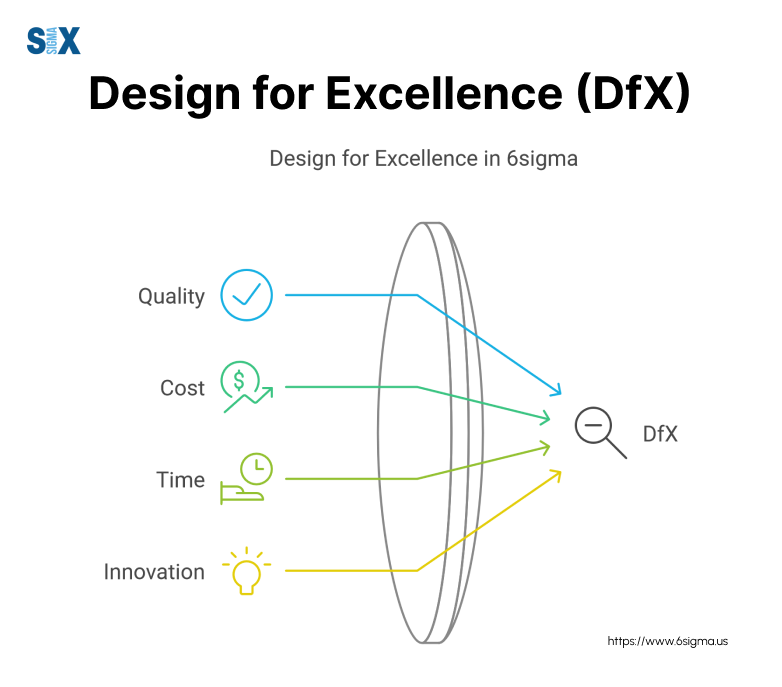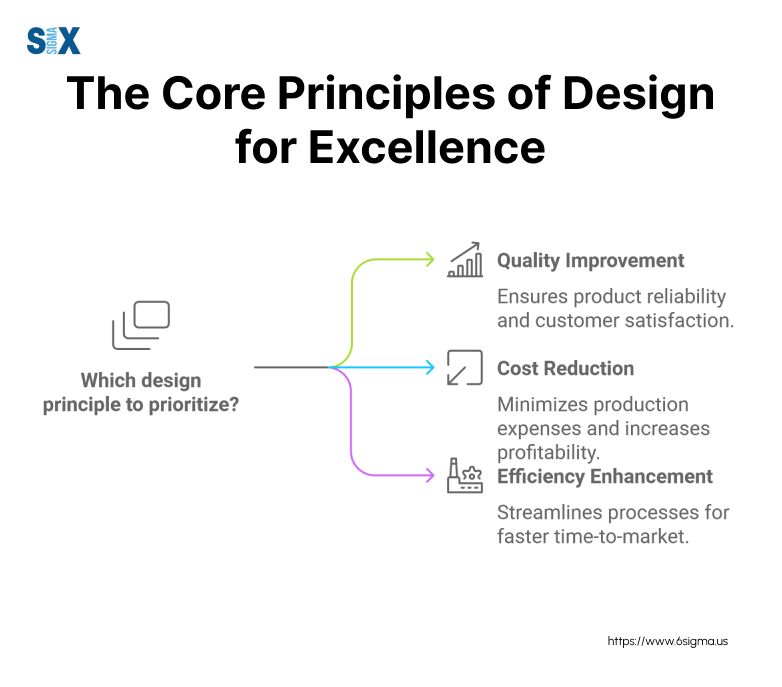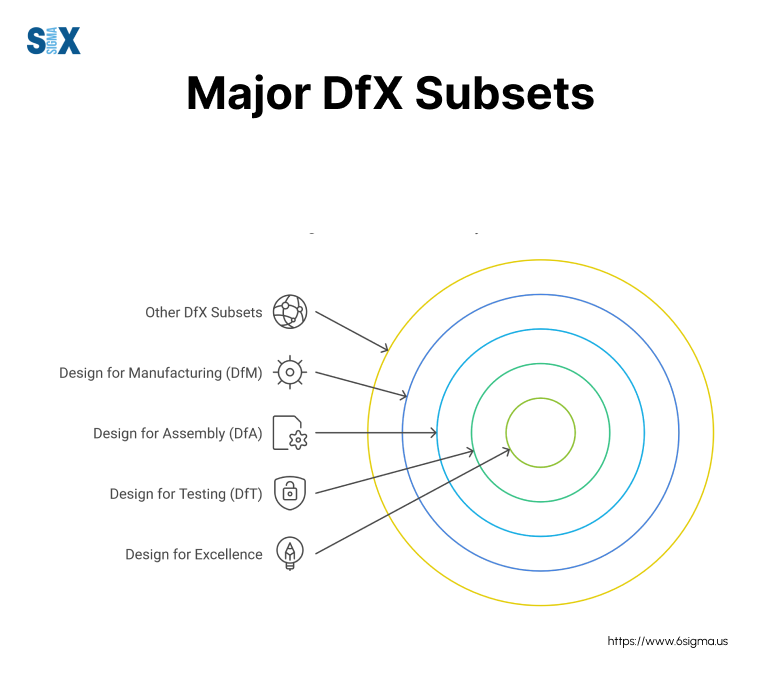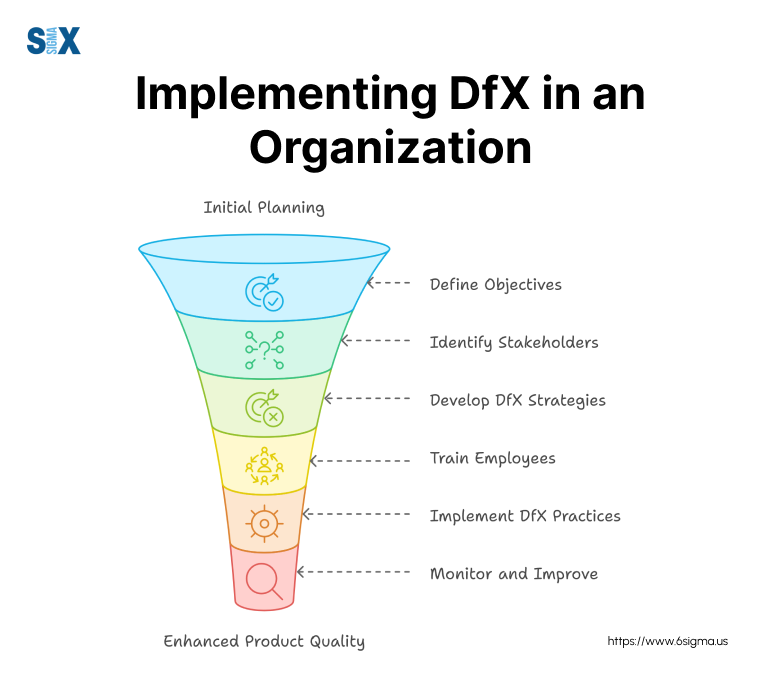Design for Excellence (Dfx): Optimizing Product Development
Excellence isn’t just a goal—it’s a necessity. Enter Design for Excellence (DfX), the game-changing approach revolutionizing product development.
This comprehensive methodology is transforming how businesses approach manufacturing, quality control, and innovation.
But what is design for excellence, exactly?
Dfx is a holistic strategy that integrates various design principles to optimize products throughout their entire lifecycle.
From conception to production and beyond, dfx design for excellence principles ensure that every aspect of a product is crafted with precision, efficiency, and foresight.
Key Highlights
- Dfx definition
- Dfx process
- Fundamentals of dfx design
- Applications in various sectors
Understanding Design for Excellence (dfx)
Design for Excellence (dfx), also known as design for x dfx or dfx is a holistic approach to product development that aims to optimize every aspect of a product’s lifecycle.
But what is design for excellence, exactly?

Dfx is a set of methodologies and principles that guide designers and engineers to create products that excel not just in functionality, but in manufacturability, reliability, sustainability, and cost-effectiveness.
Revolutionize your product design process with our DFSS White Belt course provides essential tools to implement Design for Excellence principles.
The dfx definition encompasses a wide range of considerations, from the initial concept phase through to manufacturing, use, and eventual recycling or disposal.
By implementing design for excellence principles, companies can:
- Reduce production costs
- Improve product quality
- Enhance sustainability
- Streamline manufacturing processes
- Increase customer satisfaction
Dfx is not a one-size-fits-all solution; rather, it’s a flexible framework that can be tailored to specific industries and product types.
Whether you’re designing electronics, automotive components, or consumer goods, dfx methodologies in product design can be adapted to meet your unique challenges and goals.
Design for Excellence (dfx) shares similarities with other quality improvement methodologies like Six Sigma certification , as both focus on enhancing product quality and efficiency.
History and Evolution of Dfx
The concept of designing for excellence has its roots in the mid-20th century, but it gained significant traction in the 1990s as global competition intensified and manufacturers sought ways to gain an edge.
The dfx process evolved from earlier methodologies like Design for Manufacturing (DFM) and Design for Assembly (DFA), which focused on specific aspects of product development.
As DfX evolved, it incorporated elements from other methodologies, including Lean fundamentals , to create a more comprehensive approach to product development.
This led to the development of design for x, where ‘X‘ represents various objectives such as:
- Manufacturability
- Reliability
- Testability
- Sustainability
- Serviceability
Over time, dfx design has become an integral part of modern manufacturing practices.
Today, design for excellence manufacturing is not just a competitive advantage—it’s often a necessity for companies looking to survive and thrive in a global marketplace.
The evolution of dfx has been driven by advancements in technology, changing consumer expectations, and increasing regulatory pressures.
For instance, the rise of computer-aided design (CAD) and simulation tools has made it easier for engineers to apply dfx methodologies in product design at earlier stages of development.
Design of excellence continues to evolve. Emerging technologies like artificial intelligence and machine learning are opening up new possibilities for optimizing product design and manufacturing processes.
Meanwhile, growing concerns about sustainability are pushing companies to incorporate eco-friendly design principles into their dfx strategies.
Understanding the history and evolution of dfx is crucial for anyone looking to implement these principles effectively.
By learning from past successes and failures, we can better apply design for excellence services to create products that meet the complex demands of today’s market.
The Core Principles of Design for Excellence
Design for Excellence (dfx) is built on a foundation of key principles that guide product development towards optimal outcomes.
Understanding these design for excellence principles is crucial for anyone looking to implement dfx methodologies in product design.
The focus on quality improvement in DfX aligns with principles taught in Six Sigma certification programs, emphasizing data-driven decision-making and process optimization.
Let’s explore the core pillars that make DfX such a powerful approach.

Focus on Quality Improvement
Design for excellence (dfx) is an unwavering commitment to quality. DfX enhances product quality by:
- Integrating quality considerations from the earliest design stages
- Implementing robust testing and validation processes
- Continuously refining designs based on performance data
For example, in the automotive industry, a company implementing dfx design for excellence might use advanced simulation tools to predict and optimize vehicle crash performance long before physical prototypes are built.
This proactive approach not only improves safety but also reduces the need for costly late-stage redesigns.
Cost Reduction Strategies
One of the most compelling reasons to adopt design for dfx is its potential for significant cost savings. DfX achieves this through:
- Simplifying product designs to reduce material and production costs
- Optimizing manufacturing processes to minimize waste
- Improving product reliability to reduce warranty and service costs
A real-world application of this principle can be seen in the electronics industry.
By applying dfx design principles, a smartphone manufacturer might redesign their product to use standardized components across multiple models.
This not only reduces procurement costs but also simplifies inventory management and assembly processes.
Efficiency Enhancement
The dfx process is inherently focused on enhancing efficiency across the entire product lifecycle. This is achieved by:
- Streamlining development workflows
- Reducing time-to-market through parallel design and manufacturing planning
- Improving collaboration between design, engineering, and production teams
For instance, a medical device company utilizing design for excellence manufacturing principles might implement a modular design approach.
This allows different teams to work simultaneously on various product modules, significantly reducing overall development time.
By embracing these core principles, organizations can leverage the full power of design for excellence services to create products that are not only high-quality and cost-effective but also efficient to produce and maintain.
Whether you’re a product designer, engineer, or project manager, understanding and applying these dfx methodologies in product design can significantly impact your project’s success.
As we delve deeper into the world of dfx, it’s important to remember that these principles are not isolated concepts but interconnected strategies that work together to drive excellence in product development.
Major DfX Subsets: A Detailed Exploration
Design for Excellence is a multifaceted approach that encompasses various subsets, each focusing on specific aspects of product development.
Understanding these subsets is crucial for implementing a comprehensive dfx design for excellence strategy.

Design for Manufacturing (DfM)
Design for Manufacturing (dfm) is a cornerstone of design for excellence manufacturing. It focuses on optimizing product design to facilitate efficient and cost-effective production.
The primary objectives of dfm include:
- Simplifying product designs
- Reducing manufacturing costs
- Improving product quality
- Shortening production time
Key dfm techniques and best practices include:
- Standardization of components
- Minimizing the number of parts
- Designing for easy fabrication and assembly
- Considering material selection and availability
A notable example of successful dfm implementation comes from the automotive industry. Tesla’s “Gigapress” technology, which uses massive die-casting machines to produce large vehicle parts as single pieces, has significantly reduced manufacturing complexity and costs.
Design for Assembly (DfA)
Design for Assembly (DfA) is a critical subset of dfx design that focuses on simplifying product assembly processes.
The importance of DfA lies in its potential to:
- Reduce assembly time and costs
- Improve product quality through simplified assembly
- Enhance worker safety and ergonomics
Key DfA strategies include:
- Minimizing the number of separate parts
- Designing parts for easy handling and insertion
- Standardizing components and fasteners
- Ensuring clear assembly instructions
A case study of dfa in action is Apple’s AirPods. The sleek design not only appeals to consumers but also facilitates efficient assembly with minimal components and intuitive assembly processes.
Design for Testability (DfT)
Design for Testability (DfT) is an essential aspect of design for excellence (dfx) that ensures products can be easily and effectively tested during and after production. dft plays a crucial role in quality assurance by:
- Facilitating comprehensive product testing
- Reducing testing time and costs
- Improving fault detection and diagnosis
Essential Dft methodologies include:
- Implementing built-in self-test (BIST) features
- Designing easily accessible test points
- Modular design for isolated testing of components
- Incorporating boundary scan techniques
An example of effective Dft implementation can be seen in the semiconductor industry, where chips are designed with specific test structures and scan chains to enable thorough testing during production.
Other Important DfX Subsets
While dfm, dfa, and dft form the core of many dfx methodologies in product design, several other subsets contribute to the holistic approach of dfx:
- Design for Environment (dfe): Focuses on minimizing environmental impact throughout the product lifecycle.
- Design for Reliability (dfr): Ensures products maintain performance over their intended lifespan.
- Design for Maintainability (dfmt): Facilitates easy repair and maintenance of products.
- Design for Supply Chain (dfsc): Optimizes product design for efficient sourcing, logistics, and inventory management.
These subsets work in concert to create a comprehensive design for excellence services approach, addressing various aspects of product development and lifecycle management.
By integrating these dfx subsets into your product development process, you can create products that are not only excellently designed but also optimized for manufacturing, assembly, testing, and long-term performance.
This holistic approach is what sets apart products designed for excellence from those that merely meet basic requirements.
Take your Design for Excellence skills to the next level. Our Green Belt course equips you with advanced tools to optimize every aspect of your product lifecycle.
Implementing Design for Excellence in Product Development
Implementing design for excellence (dfx) principles can transform your product development process, leading to superior products and more efficient manufacturing.
This section provides a comprehensive guide on how to integrate dfx methodologies into your workflow, overcome common challenges, and measure the success of your implementation.

Step-by-Step Guide to Dfx Implementation
Adopting dfx design for excellence requires a systematic approach.
Here’s a step-by-step process to help you get started:
- Assess Current Processes: Evaluate your existing product development workflow to identify areas for improvement.
- Set Clear Objectives: Define specific goals for your dfx implementation, such as reducing manufacturing costs or improving product quality.
- Choose Relevant dfx Subsets: Based on your objectives, select the most appropriate dfx methodologies (e.g., dfm, dfa, dft).
- Form a Cross-Functional Team: Assemble a team with diverse expertise to ensure all aspects of the product lifecycle are considered.
- Develop dfx Guidelines: Create a set of design rules and best practices tailored to your organization’s needs.
- Integrate dfx Tools: Implement software tools that support dfx analysis and decision-making.
- Train Your Team: Provide comprehensive training on dfx principles and tools to ensure widespread adoption.
- Pilot Implementation: Start with a small project to test your dfx approach and identify any issues.
- Scale and Refine: Gradually expand dfx implementation across all projects, continuously refining your approach based on feedback and results.
Challenges in DfX Adoption and How to Overcome Them
While the benefits of design for excellence manufacturing are clear, organizations often face obstacles when implementing DfX.
Here are some common challenges and solutions:
- Resistance to Change:
• Challenge: Employees may be reluctant to adopt new methodologies.
• Solution: Communicate the benefits of dfx clearly and involve team members in the implementation process. - Lack of Expertise:
• Challenge: Teams may lack the necessary skills to implement dfx effectively.
• Solution: Invest in comprehensive training programs and consider bringing in external design for excellence services. - Siloed Departments:
• Challenge: Poor communication between design, manufacturing, and other departments.
• Solution: Foster a culture of collaboration and implement regular cross-functional meetings. - Time Constraints:
• Challenge: Pressure to rush products to market may compromise dfx implementation.
• Solution: Demonstrate how dfx can actually reduce time-to-market in the long run by minimizing redesigns and manufacturing issues.
To address the lack of expertise, companies often invest in training programs, such as Six Sigma Green Belt certification or Lean introduction courses, to equip their teams with the necessary skills.
Measuring the Success of DfX Implementation
To ensure your dfx process is delivering results, it’s crucial to track key performance indicators (KPIs) and continuously improve your approach.
Here are some essential metrics to consider:
- Time-to-Market: Measure the reduction in product development cycle time.
- Manufacturing Costs: Track the decrease in production expenses.
- Quality Metrics: Monitor improvements in product quality and reduction in defects.
- Customer Satisfaction: Assess the impact of dfx on user experience and product reviews.
- Return on Investment (ROI): Calculate the overall financial impact of your dfx implementation.
Regularly review these metrics and use the insights gained to refine your dfx methodologies in product design.
Utilizing root cause analysis techniques, often taught in Six Sigma Yellow Belt certification, can help identify and address issues in DfX implementation.
Lead transformative design projects with our DFSS Green Belt course provides comprehensive training in Design for Excellence methodologies. Empower yourself to drive innovation and quality in your organization!
Embracing Design for Excellence in Your Product Development
Throughout this article, we’ve explored the transformative power of Design for Excellence (dfx) and its potential to revolutionize product development processes.
From understanding what is design for excellence to delving into the intricacies of dfx methodologies in product design, we’ve covered a comprehensive landscape of this crucial approach.
We’ve seen how design for excellence (dfx) principles can significantly enhance product quality, reduce costs, and streamline manufacturing processes.
By implementing dfx design for excellence strategies, organizations can stay ahead.
Key takeaways include:
- The holistic nature of dfx, encompassing various subsets like dfm, dfa, and dft
- The importance of integrating design for excellence manufacturing principles early in the product lifecycle
- The role of dfx design in fostering innovation and efficiency
- The challenges and solutions in implementing a robust dfx process
As we’ve discovered, design of x is not just a set of guidelines but a mindset that drives continuous improvement and excellence in product development.
Whether you’re a product designer, engineer, or business leader, adopting dfx principles can lead to significant competitive advantages.
Remember, the journey to excellence is ongoing.
As technology evolves and new challenges emerge, your approach to dfx should also adapt and grow. Stay curious, keep learning, and always strive for excellence in every aspect of your product development process.
By embracing dfx, you’re not just designing products; you’re designing for excellence, efficiency, and long-term success.
Start your dfx journey today and transform the way you approach product development.
SixSigma.us offers both Live Virtual classes as well as Online Self-Paced training. Most option includes access to the same great Master Black Belt instructors that teach our World Class in-person sessions. Sign-up today!
Virtual Classroom Training Programs Self-Paced Online Training Programs






